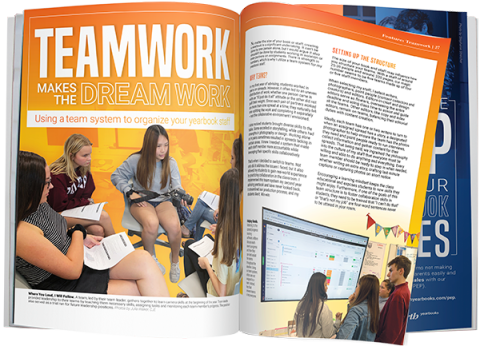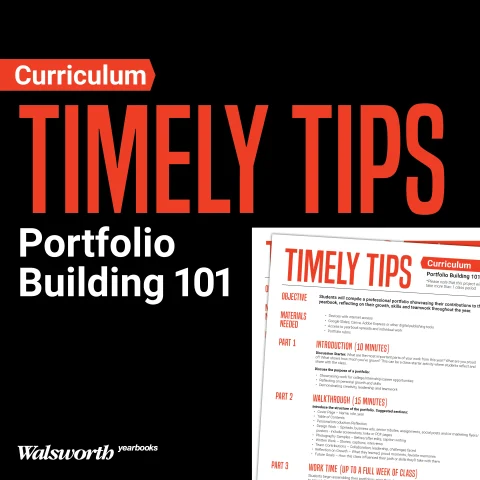No matter the size of your book or staff, creating a yearbook is a significant undertaking. It can’t be done by one person alone, but I would argue it also shouldn’t be done by students working in isolation or even partners on assignments. There is strength in numbers, which is why I utilize a team system for my yearbook staff.
WHY TEAMS?
In my first year of advising, students worked in pairs on spreads. However, it often led to an uneven distribution of work, whether one person came in with an “I’ll just do it all” attitude or the other did not pull their weight. Since each pair of partners worked on more than one spread at a time, they naturally fell into splitting the work and completing it separately – not the collaborative environment I envisioned.
I also noticed students brought diverse skills to the table. Some excelled in storytelling, while others had strengths in photography or design. Working alone or in pairs sometimes resulted in spreads lacking in certain areas. I knew I needed a system that made each staff member more accountable while leveraging their specific skills collaboratively.
That’s when I decided to switch to teams. Not only did it address the issues I faced, but it also allowed my students to gain real-world experience by practicing collaboration in the classroom. I implemented this team system my second year advising yearbook and have never looked back. It streamlined our production process, and my students like it. Win-win.
SETTING UP THE STRUCTURE
The size of your book and staff may influence how you structure your teams. With a staff of around 25-30 people and around 320 pages, our magic number seems to be five teams made up of four or five staff members.
When selecting my staff, I select writers, photographers, point people (content collectors and creators) and editors. Editors-in-chief and design editors serve as floaters, overseeing the entire deadline and using class time to assist and guide all the teams. Other editors, like copy and index editors, remain on teams, balancing their editorial duties with content creation.
Ideally, each team has one or two writers to turn to when an assigned spread has a story, a designated photographer to help ensure the team has the photos they need and point people ready to run interviews, collect information and gather content for their spreads. That being said, we ingrained the philosophy into the culture of my staff that everyone must be willing and able to do anything and everything. Every team member should be ready to step in when needed, whether writing an extra story, crafting last-minute captions or capturing photos on short notice.
Encouraging a learning mindset keeps the class educational and exposes students to new skills they might enjoy. Furthermore, if one of the goals of this team structure is to foster collaboration skills in students, they need to be trained that “I can’t do that” or “that’s not my job” are four-word sentences never to be uttered in your room.
TEAM LEADS
Every team is led by a team lead, a privileged leadership position my students look forward to fulfilling in addition to their roles as writers, photographers or point people. I try to keep team leads consistent throughout the year so they can refine their leadership skills as time goes on. However, flexibility is key. I’ve needed to switch up team leads mid-year for a variety of reasons in the past.
Previous experience is a must when it comes to team leads. Since I rely on them heavily to mentor their teammates and jump into action during deadlines, I require experience from either a previous year on staff or previous deadlines if they are tapped into the role mid-year.
The team lead role serves as a stepping stone for future editorial positions, offering invaluable leadership experience. When students use this opportunity to become editors-in-training, I can identify those who excel under pressure and those who may need further development in leadership.
TEAMS IN ACTION
Every deadline cycle looks different, but usually, each team works on three-to-four spreads or a combination of spreads and tasks, like portrait section mods, club photo pages content, short profiles, etc. After we assign spreads, the teams get to work.
The team lead decides what content will be covered on each spread and what tasks the team needs to complete. This list of tasks and content is written on a pre-made “Deadline Spread Progress” Google Doc template for easy reference and tracking as the deadline progresses. On that same document, the team divides assignments as evenly as possible among staff members and adds their names next to tasks on the “Spread Progress” document. This allows for individual contributions based on specialization.
The team structure promotes shared responsibility, ensuring if one member falters or faces an unexpected absence, others can step in to maintain progress. This collective approach also prevents burdens from falling solely on one person.
So how long do these teams stay together? I prefer to switch teams every other deadline cycle. This allows time for members to familiarize themselves with each other’s work styles and skills. However, after deadlines, I often sense the itch for my staff to start working with fresh faces. Allowing a periodic switch up allows more relationships to build, strengthening the bond of the staff.
MAKING IT FUN
One of the benefits of producing a yearbook within teams is how easily this lends itself to friendly competition amongst the staff, a key component of my students’ motivation throughout even the most stressful deadlines.
Inspired loosely by the Hogwarts house points system, I award teams points periodically throughout a deadline cycle for meeting deadlines, such as story rough drafts, spread check-ins and final deadlines. At the end of a deadline cycle, I pick out my favorite story, headline, photo, mod, overall design and more for my much-anticipated deadline awards. Each deadline and award contributes to the team’s tally, and the team with the most points at the end wins. Winning teams earn first pick for next deadline’s spreads and can also pick a sticker out of my vinyl sticker collection (I highly recommend Red Bubble to order all the journalism, Taylor Swift, Barbie, and for us, Chiefs- and Kansas City-themed stickers) to proudly display on their laptop or water bottle.
Furthermore, placing the staff in teams allows me to implement impromptu games quickly. We’ve done quick trivia competitions, caption-writing relay races and newspaper costume-making games.
Taking time for the team to bond and for the entire class to have fun together is invaluable in building a productive and happy staff, and the teams structure allows us to do just that.





